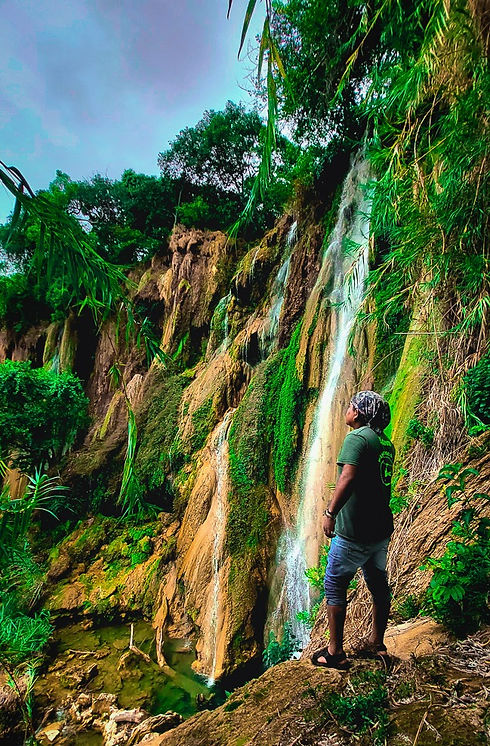
DISCOVER THE HISTORY OF A THOUSAND WATERFALLS
A natural paradise with deep roots and a lively spirit.

Everything is better
if we value the origin
Our roots
Long before there were maps with borders, this land already offered the essentials for life: water, food, and balance.
The Chontal region—with its fertile lands and hidden deposits—was a true oasis for indigenous peoples. Although far from lakes or lagoons, springs, underground rivers, and waterfalls gushed forth here, nourishing the land and those who inhabited it.
That constant flow of water was what enabled cultivation, community life… and also the spiritual connection with nature.
Among its most prized treasures were—and still are—the borbollón water baths , small natural pools of crystal-clear water that emerge from the ground as if the earth itself were breathing. Warm in winter, cool in summer, and always ready to renew body and soul.
This is not a tourist spot.
It is a territory with soul.
And that's why every step you take here is a way of returning to the origin.
Why is it called Thousand Waterfalls?
When you arrive at this place and hear the sound of water falling from all around, the name seems logical... but in reality, it has much deeper roots.
Hundreds of years ago, this territory was inhabited by the Chontales. Their language was so complex and guttural that when the Spanish arrived, they simply couldn't pronounce it. To make evangelization easier, the friars imposed Nahuatl, a more accessible language for them. It was then that this place began to be called Xocohuéyatl .
The meaning?
“Xocotl” which means pomegranate —because of the wild fruits that grew throughout the area.
“Huéyatl” , which means large or mighty waterfall .
This is how this peculiar name was born:
Pomegranates and their Thousand Cascades.
They were not counted one by one.
It was a poetic way of describing what it felt like to be here:
a thousand ways to fall, a thousand ways to flow, a thousand ways to be reborn.
During the War of Independence and the Revolution, this place was an obligatory stopover for rebel caravans. A place to rest, rehydrate, and regain strength. Perhaps that's why, to this day, Mil Cascadas remains just that: a place that resets you.
Today, that name is honored as a bridge between the past and the present.
And you don't need to speak Nahuatl to feel what it means.

The eyes that discovered
"A Thousand Waterfalls"
Before Mil Cascadas had a name, there were already those who could see its grandeur. One of those people was Sonya Michael Silverstone , a woman ahead of her time, born in Portland, Oregon, in 1896. Jewish, a scientist, and passionate about biology, she arrived in this corner of Guerrero with the curious gaze of someone who recognizes life in its purest form.
Together with her husband, Herschel Silverstone , she acquired these lands in the mid-20th century. By 1949, they were already living in a modern residence designed by Anshen + Allen Architects , whose architectural vision sought to coexist with the jungle, not dominate it. The house, avant-garde for its time, was even featured in House Beautiful magazine, with photographs by Maynard Parker and comments from personalities such as Frances Heard and Elizabeth Gordon , who found in this place an almost secret paradise.
Sonya didn't come here just passing through. She was registered by the Mexican Immigration Service in 1949 for residency and scientific research purposes, which makes it clear that this place chose her as much as she chose it . She loved the land, its people, the history, and the secrets hidden among the rocks and trees.
His home became a meeting point for explorers, researchers, and friends who crossed borders just for the privilege of immersing themselves in this living nature. His legacy is not only architectural or scientific: it is emotional. It is a seed planted in fertile soil that still bears fruit.
Sonya died in San Francisco in 1953, at the age of 56. Herschel died in 1961. But anyone who walks this place today will do so in her footsteps. Because this piece of the world has history, memory… and people who knew how to see it before everyone else.
Sources consulted: Immigration record of Sonya Michael Silverstone issued by the Mexican Consulate in Laredo, Texas (1949, Immigration Service #249205), informal photographic archive of The Huntington Library, Art Museum and Botanical Gardens, and editorial notes from House Beautiful magazine (circa 1950).
This ancient corner, filled with natural power and pure beauty, continues to thrive thanks to the commitment of the people who care for it. Las Granadas and its Thousand Waterfalls are not just a landscape: they are the result of generations who have protected its biodiversity with respect, love, and purpose. Here, nature is not domesticated… it is honored.

Thousand Waterfalls today:
An eco-adventure park
Over time, Las Granadas and its Thousand Waterfalls have evolved, joining the conscious and sustainable tourism movement. Today, this place is experienced as an eco-adventure park , where every visitor not only enjoys but also actively participates in environmental conservation.
More than a destination, it's a place to reconnect with the Earth, learn, explore, and be part of something bigger. Thousand Falls isn't just its current name: it's a promise to preserve what matters, to share with respect, and to inspire a future where nature remains the centerpiece.




